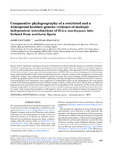Comparative Phylogeography of a Restricted and a Widespread Heather: Genetic Evidence of Multiple Independent Introductions of Erica Mackayana Into Ireland From Northern Spain

Ver/
Use este enlace para citar
http://hdl.handle.net/2183/32759
A non ser que se indique outra cousa, a licenza do ítem descríbese como Atribución-NoComercial-SinDerivadas 4.0 Internacional
Coleccións
Metadatos
Mostrar o rexistro completo do ítemTítulo
Comparative Phylogeography of a Restricted and a Widespread Heather: Genetic Evidence of Multiple Independent Introductions of Erica Mackayana Into Ireland From Northern SpainData
2023-01-20Cita bibliográfica
Jaime Fagúndez, Pilar Díaz-Tapia, Comparative phylogeography of a restricted and a widespread heather: genetic evidence of multiple independent introductions of Erica mackayana into Ireland from northern Spain, Botanical Journal of the Linnean Society, Volume 201, Issue 3, March 2023, Pages 329–340, https://doi.org/10.1093/botlinnean/boac071
Resumo
[Abstract] Species of flora and fauna occurring in the west of Ireland and south-west Europe, known as Lusitanian elements, constitute a puzzling case of isolated populations of uncertain origin. Here we studied the population genetic structure of the heather Erica mackayana in Ireland and northern Spain and compared it with its widespread close relative Erica tetralix using single nucleotide polymorphisms (SNPs). We reconstructed phylogenetic relationships using maximum likelihood (ML), inferred population genetic structure using cluster assignment and principal component analysis, and estimated population genetic diversity. The cluster analysis and ML phylogenetic tree showed a geographical pattern for E. tetralix supporting a post-glacial migration from Iberia to Ireland. In contrast, Irish populations of E. mackayana were supported in independent clades in the phylogenetic tree and shared clusters with Iberian populations in the structure analysis, and FST values were lower among Irish and Spanish populations than among Irish ones. This suggests that Irish populations of E. mackayana are the result of recent multiple independent introductions from its native area in northern Spain, probably assisted by humans. However, the origin of the largest Irish population at Roundstone Bog is unclear and should be further investigated. Post-glacial, long-distance dispersal is the most plausible explanation for Lusitanian species distribution in Ireland.
Palabras chave
Erica tetralix
Hiberno-Iberian species
Lusitanian species
SNPs
Hiberno-Iberian species
Lusitanian species
SNPs
Descrición
Financiado para publicación en acceso aberto: Universidade da Coruña/CISUG
Versión do editor
Dereitos
Atribución-NoComercial-SinDerivadas 4.0 Internacional
ISSN
1095-8339






